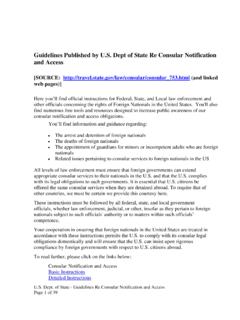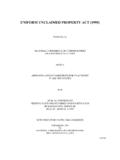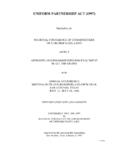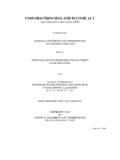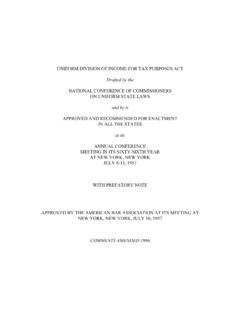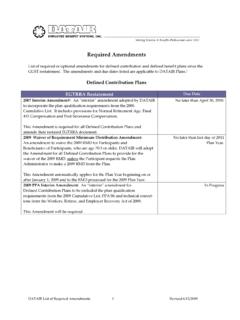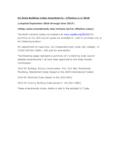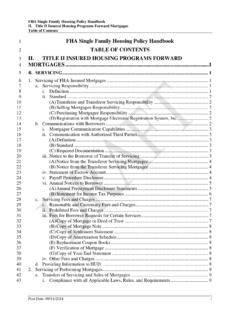Transcription of UNIFORM TRADE SECRETS ACT WITH 1985 …
1 UNIFORM TRADE SECRETS ACT WITH 1985 AMENDMENTS Drafted by the NATIONAL CONFERENCE OF COMMISSIONERS ON UNIFORM STATE LAWS and by it Approved and Recommended for Enactment in All the States At its ANNUAL CONFERENCE MEETING IN ITS NINETY-FOURTH YEAR IN MINNEAPOLIS, MINNESOTA AUGUST 2-9, 1985 With Prefatory Note and Comments Approved by the American Bar Association Baltimore, Maryland, February 11, 1986 UNIFORM TRADE SECRETS ACT WITH 1985 AMENDMENTS The Committee that acted for the National Conference of Commissioners on UNIFORM State Laws in preparing the UNIFORM TRADE SECRETS Act with 1985 Amendments was as follows: LINDSEY COWEN, 24 Ridgewood Drive, Cartersville, GA 30120, Chairman THOMAS E.
2 CAVENDISH, 31st Floor, 41 South High Street, Columbus, OH 43215 ROBERT H. CORNELL, 25th Floor, 50 California Street, San Francisco, CA 94111 RICHARD COSWAY, University of Washington, School of Law, Seattle, WA 98105 RICHARD F. DOLE, JR., University of Houston, Law Center, 4800 Calhoun, Houston, TX 77004 CARLYLE C. RING, JR., Room 322-D, 5390 Cherokee Avenue, Alexandria, VA 22312, President (Member Ex Officio) WILLIAM J. PIERCE, University of Michigan, School of Law, Ann Arbor, MI 48109, Executive Director Final, approved copies of all UNIFORM and Model Acts and other printed matter issued by the Conference may be obtained from: NATIONAL CONFERENCE OF COMMISSIONERS ON UNIFORM STATE LAWS 645 North Michigan Avenue, Suite 510 Chicago, Illinois 60611 (312) 321-9710 UNIFORM TRADE SECRETS ACT WITH 1985 AMENDMENTS TABLE OF CONTENTS PREFATORY NOTE SECTION 1.
3 DEFINITIONS 2. INJUNCTIVE RELIEF 3. DAMAGES 4. ATTORNEY'S FEES 5. PRESERVATION OF SECRECY 6. STATUTE OF LIMITATIONS 7. EFFECT ON OTHER LAW 8. UNIFORMITY OF APPLICATION AND CONSTRUCTION 9. SHORT TITLE 10. SEVERABILITY 11. TIME OF TAKING EFFECT 12. REPEAL 1 UNIFORM TRADE SECRETS ACT WITH 1985 AMENDMENTS (The 1985 Amendments are Indicated by Underscore and Strikeout) PREFATORY NOTE A valid patent provides a legal monopoly for seventeen years in exchange for public disclosure of an invention. If, however, the courts ultimately decide that the Patent Office improperly issued a patent, an invention will have been disclosed to competitors with no corresponding benefit.
4 In view of the substantial number of patents that are invalidated by the courts, many businesses now elect to protect commercially valuable information through reliance upon the state law of TRADE secret protection. Kewanee Oil Co. v. Bicron Corp., 416 470 (1974), which establishes that neither the Patent Clause of the United States Constitution nor the federal patent laws pre-empt state TRADE secret protection for patentable or unpatentable information, may well have increased the extent of this reliance. The recent decision in Aronson v. Quick Point Pencil Co., 99 1096, 201 USPQ 1 (1979) reaffirmed Kewanee and held that federal patent law is not a barrier to a contract in which someone agrees to pay a continuing royalty in exchange for the disclosure of TRADE SECRETS concerning a product.
5 Notwithstanding the commercial importance of state TRADE secret law to interstate business, this law has not developed satisfactorily. In the first place, its development is uneven. Although there typically are a substantial number of reported decisions in states that are commercial centers, this is not the case in less populous and more agricultural jurisdictions. Secondly, even in states in which there has been significant litigation, there is undue uncertainty concerning the parameters of TRADE secret protection, and the appropriate remedies for misappropriation of a TRADE secret. One commentator observed: "Under technological and economic pressures, industry continues to rely on TRADE secret protection despite the doubtful and confused status of both common law and statutory remedies.
6 Clear, UNIFORM TRADE secret protection is urgently needed.." Comment, "Theft of TRADE SECRETS : The Need for a Statutory Solution", 120 378, 380-81 (1971). In spite of this need, the most widely accepted rules of TRADE secret law, 757 of the Restatement of Torts, were among the sections omitted from the Restatement of Torts, 2d (1978). The UNIFORM Act codifies the basic principles of common law TRADE secret protection, preserving its essential distinctions from patent law. Under both the Act and common law 2 principles, for example, more than one person can be entitled to TRADE secret protection with respect to the same information, and analysis involving the "reverse engineering" of a lawfully obtained product in order to discover a TRADE secret is permissible.
7 Compare UNIFORM Act, Section 1(2) (misappropriation means acquisition of a TRADE secret by means that should be known to be improper and unauthorized disclosure or use of information that one should know is the TRADE secret of another) with Miller v. Owens-Illinois, Inc., 187 USPQ 47, 48 ( ) (alternative holding) (prior, independent discovery a complete defense to liability for misappropriation) and Wesley-Jessen, Inc., v. Reynolds, 182 USPQ 135, 144-45, ( ) (alternative holding) (unrestricted sale and lease of camera that could be reversed engineered in several days to reveal alleged TRADE SECRETS preclude relief for misappropriation).
8 For liability to exist under this Act, a Section 1(4) TRADE secret must exist and either a person's acquisition of the TRADE secret, disclosure of the TRADE secret to others, or use of the TRADE secret must be improper under Section 1(2). The mere copying of an unpatented item is not actionable. Like traditional TRADE secret law, the UNIFORM Act contains general concepts. The contribution of the UNIFORM Act is substitution of unitary definitions of TRADE secret and TRADE secret misappropriation, and a single statute of limitations for the various property, quasi-contractual, and violation of fiduciary relationship theories of noncontractual liability utilized at common law.
9 The UNIFORM Act also codifies the results of the better reasoned cases concerning the remedies for TRADE secret misappropriation. The History of the Special Committee on the UNIFORM TRADE SECRETS Act On February 17, 1968, the Conference's subcommittee on Scope and Program reported to the Conference's Executive Committee as follows: "14. UNIFORM TRADE SECRETS Protection Act. This matter came to the subcommittee from the Patent Law Section of the American Bar Association from President Pierce, Commissioner Joiner and Allison Dunham. It appears that in 1966 the Patent Section of the American Bar Association extensively discussed a resolution to the effect that 'the ABA favors the enactment of a UNIFORM state law to protect against the wrongful disclosure or wrongful appropriation of TRADE SECRETS , know-how or other information maintained in confidence by another.
10 ' It was decided, however, not to put such a resolution to a vote at that time but that the appropriate Patent Section Committee would further consider the problem. In determining what would be appropriate for the Conference to do at this juncture, the following points should be considered: (1) At the present much is going on by way of statutory development, both federally and in the states. 3 (2) There is a fundamental policy conflict still unresolved in that the current state statutes that protect TRADE SECRETS tend to keep innovations secret, while our federal patent policy is generally designed to encourage public disclosure of innovations.


